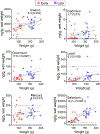Some metals and metalloids in the blood of three species of shorebirds increase while foraging during two-week migratory stopover in Delaware Bay, New Jersey
- PMID: 37748669
- PMCID: PMC10841762
- DOI: 10.1016/j.envres.2023.117194
Some metals and metalloids in the blood of three species of shorebirds increase while foraging during two-week migratory stopover in Delaware Bay, New Jersey
Abstract
Most migratory shorebird species are declining, some are endangered, and some may be vulnerable to contaminants on long distance travel between wintering grounds and high latitude breeding grounds. We examined whether shorebirds accumulated trace elements at the Delaware Bay (New Jersey) stopover by testing the null hypothesis that there was no difference in the levels of arsenic, cadmium, chromium, lead, mercury, and selenium in blood of three species of shorebirds collected early in their stopover compared to levels in blood collected about two weeks later near the end of the stopover, before departing for breeding grounds. There were significantly higher levels of all metals and metalloids in the blood of ruddy turnstone (Arenaria interpres) later in May than earlier. There were seasonal increases in blood levels of arsenic and selenium for all three species. Chromium and lead levels also increased in red knots (Calidris canutus). These increases occurred although the birds were only present for about two weeks. Levels of arsenic, mercury, and lead in knots and selenium in sanderlings (Calidrris alba), exceeded reported effects levels. These results have potential implications for studying the refueling physiology, energetics, and feeding behavior of migratory shorebirds. However, they also suggest cause for concern because the increased contaminant loads occur in a short period, and the high metal level bolus received all in a few days may result in adverse effects.
Keywords: Arsenic; Lead; Mercury; Metals and metalloids; Migratory risk; Selenium; Short-term uptake.
Copyright © 2023 Elsevier Inc. All rights reserved.
Conflict of interest statement
Declaration of competing interest The authors declare that they have no known competing financial interests or personal relationships that could have appeared to influence the work reported in this paper.
Figures





Similar articles
-
Trace element contamination in three shorebird species migrating through Delaware Bay, New Jersey: arsenic, mercury and selenium are increasing.Ecotoxicology. 2025 Jan;34(1):89-101. doi: 10.1007/s10646-024-02816-1. Epub 2024 Oct 29. Ecotoxicology. 2025. PMID: 39472415 Free PMC article.
-
Habitat risk: Use of intertidal flats by foraging red knots (Calidris canutus rufa), ruddy turnstones, (Arenaria interpres), semipalmated sandpipers (Calidris pusilla), and sanderling (Calidris alba) on Delaware Bay beaches.Environ Res. 2018 Aug;165:237-246. doi: 10.1016/j.envres.2018.04.028. Epub 2018 May 7. Environ Res. 2018. PMID: 29734024
-
Metals in tissues of migrant semipalmated sandpipers (Calidris pusilla) from Delaware Bay, New Jersey.Environ Res. 2014 Aug;133:362-70. doi: 10.1016/j.envres.2014.05.020. Epub 2014 Jun 18. Environ Res. 2014. PMID: 24952461
-
Mercury (Hg), Lead (Pb), Cadmium (Cd), Selenium (Se), and Arsenic (As) in Liver, Kidney, and Feathers of Gulls: A Review.Rev Environ Contam Toxicol. 2019;247:85-146. doi: 10.1007/398_2018_16. Rev Environ Contam Toxicol. 2019. PMID: 30413976 Review.
-
Pollution status of heavy metals and metalloids in Chinese lakes: Distribution, bioaccumulation and risk assessment.Ecotoxicol Environ Saf. 2022 Dec 15;248:114293. doi: 10.1016/j.ecoenv.2022.114293. Epub 2022 Nov 17. Ecotoxicol Environ Saf. 2022. PMID: 36403301 Review.
Cited by
-
Trace element contamination in three shorebird species migrating through Delaware Bay, New Jersey: arsenic, mercury and selenium are increasing.Ecotoxicology. 2025 Jan;34(1):89-101. doi: 10.1007/s10646-024-02816-1. Epub 2024 Oct 29. Ecotoxicology. 2025. PMID: 39472415 Free PMC article.
-
A Systematic Review and Quantitative Synthesis of Metal and Metalloid Contamination in Avian Species in Brazil.Biol Trace Elem Res. 2025 Aug 9. doi: 10.1007/s12011-025-04778-9. Online ahead of print. Biol Trace Elem Res. 2025. PMID: 40782181
-
Bioaccumulation of Some Metals and Metalloids in Laughing Gulls (Leucophaeus atricilla): Increases in Mercury and Decreases in Selenium from 2019 to 2022/2023.Toxics. 2023 Dec 9;11(12):1007. doi: 10.3390/toxics11121007. Toxics. 2023. PMID: 38133408 Free PMC article.
References
-
- Ackerman E, Ambrogio E, Esher D, Rhoads E, Thomson R, Ubiet L, Uricheck A (1998). Contamination issues in the Delaware River basin: Present and future., pp 234–245 In Ecology and restoration of the Delaware River Basin. Majumdar SK, Miller EW, Sage LE (eds). Penn Acad Sci. Easton PA.
-
- Agency for Toxic Substances and Disease Registry (ATSDR). (1996). Toxicological profile for selenium. Agency for Toxic Substances and Disease Registry, US Public Health Service. Atlanta, Georgia.
-
- Agency for Toxic Substances and Disease Registry (ATSDR). (1999). Toxicological profile for mercury. Agency for Toxic Substances and Disease Registry, US Public Health Service: Atlanta, Georgia.
-
- Agency for Toxic Substances and Disease Registry (ATSDR). (2007a). Toxicological profile for cadmium. Agency for Toxic Substances and Disease Registry, US Public Health Service. Atlanta, Georgia.
Publication types
MeSH terms
Substances
Grants and funding
LinkOut - more resources
Full Text Sources
Medical
Miscellaneous

